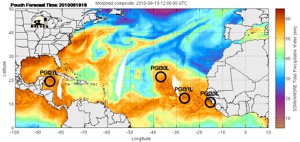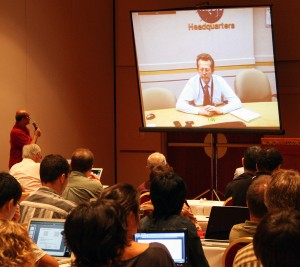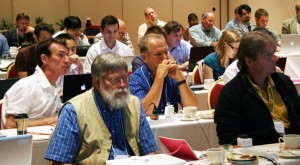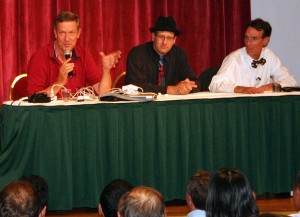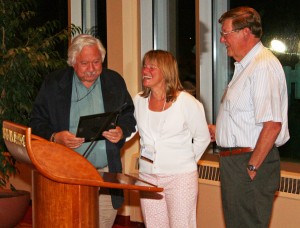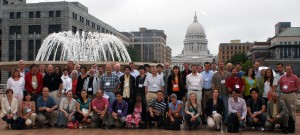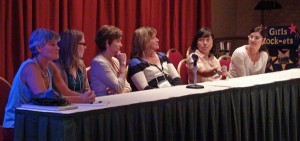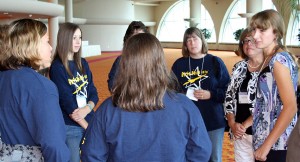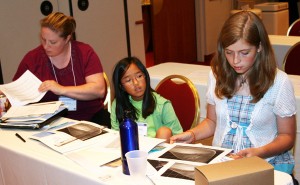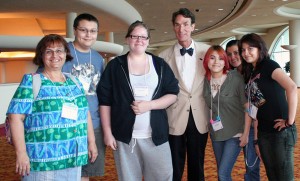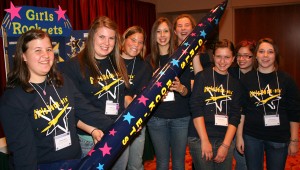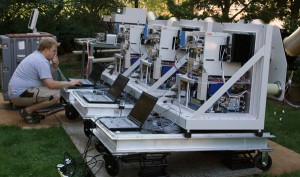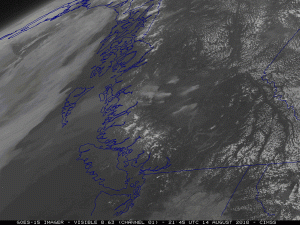Monthly News Summary – September 2010
- SSEC Researchers Deploy with PREDICT
- VEXAG Conference Highlights Venus Exploration
- SSEC Promotes STEM Careers for Girls
- SSEC Increases AERI Instrument Assembly
- UW Implements Real-Time Hurricane Forecasting and Tracking
- CIMSS Re-Compete Success Makes Headlines
- Steve Ackerman Headlines New Video Series
- Museum Proposal to be Re-Submitted
- CIMSS VISIT Activities and CIMSS Satellite Blog Updates
- Tropical Cyclone Updates on the CIMSS Satellite Blog
- WMO Scientific Advisory/Steering Group on Volcanic Ash
- CIMSS and ASPB Visit NWS Facilities in Hawaii Representing the GOES-R Proving Ground
SSEC Researchers Deploy with PREDICT
At the end of August CIMSS scientists Chris Velden and Derrick Herndon along with AOS graduate students John Sears and Sarah Monette deployed to St. Croix where they will be providing support for PREDICT (Pre-Depression Investigation of Cloud-systems in the Tropics). The major field campaign is being conducted in tandem with two other field campaigns IFEX (NOAA) and GRIP (NASA).
In addition to US Air Force C-130 aircraft, three additional piloted aircraft, along with a Global Hawk UAV carrying a variety of instruments, will be used to gather data in an attempt to better understand why some tropical disturbances develop into tropical depressions while others do not.
The CIMSS team will assist in aircraft mission planning, forecasting and possibly evacuation decisions should the island be threatened by a hurricane. The team will depart the island 10 September but will continue to be directly involved in the program until it’s completion 30 September.
CIMSS has established a special web site for PREDICT where satellite imagery and observation data along with derived products are provided for each disturbance of interest. The products allow forecasters to evaluate the environment surrounding developing disturbances and provide insight into the structure and intensity change of both nascent and fully developed tropical cyclones. An active hurricane season is anticipated this year. Scientists are hoping for the opportunity to study a significant number of disturbances which eventually go on to become storms while at the same time remaining far enough away to not threaten populated areas.
CIMSS MIMIC-TPW product with disturbances of interest marked with circles.
The students involved in PREDICT have started a blog chronicling their experiences.
VEXAG Conference Highlights Venus Exploration
The Venus Explorations Analysis Group (VEXAG) convened at the Monona Terrace Convention Center for its annual workshop on 30 August – 2 September 2010. Co-chaired by Professor Sanjay Limaye of SSEC, the workshop featured scientists and researchers from around the globe, presenting and discussing details of current and upcoming Venus missions, including Japan’s Akatsuki and Russia’s Venera-D missions, and the future of Venus exploration.
Many comprehensive presentations addressed available spacecraft and ground-based observations to answer some of the major questions about the atmosphere of Venus. Discussions focused on addressing key unresolved questions using models and observations and the possibilities of yet to be proposed Venus explorations.
Interactive video conferencing brought Dr. James Green, Director of the NASA/SMD Solar System Exploration division, to the meeting to answer questions and speak about the future of NASA Venus projects. Dr. Sanjay Limaye led the session.
Bill Nye (far left), new Executive Director of the Planetary Society, listens to James Green’s opening remarks.
The workshop fostered coordination between various international missions to Venus to maximize science return. The NASA/Planetary Science Division’s newly formed Technology Committee held its meeting in conjunction with the workshop. The workshop was followed by the 8th VEXAG meeting on 2 September 2010.
A public presentation, “Impacts, Planetary Climates, & Venus!” was held Tuesday evening, 31 August 2010, and featured:
- Bill Nye (“The Science Guy”), Executive Director of the Planetary Society
- David Grinspoon, author and astrobiologist, Denver Museum of Nature and Science
- Jan Smit, Earth and Life Sciences department, VU University Amsterdam
From left: Jan Smit, David Grinspoon, Bill Nye
A hugely enthusiastic crowd filled the auditorium, which seats 315, to capacity and two large additional rooms were equipped with large video monitors for the overflow crowd
Ellen Stofan (Proxemy Research) and Thomas Thompson (JPL) present a certificate to Steve Saunders commemorating his lifelong commitment to Venus Exploration..
The VEXAG attendees.
SSEC Promotes STEM Careers for Girls
SSEC’s Office of Space Science Education conducted a workshop entitled, “Promoting STEM (Science, Technology, Engineering and Mathematics) Careers for Girls” in conjunction with the VEXAG Workshop at the Monona Terrace Convention Center on 31 August 2010.
The program was co-sponsored by NASA, the National Girls’ Collaborative (NGC) and the Wisconsin Department of Public Instruction. Over 110 teachers, students, UW-System faculty and staff, and community STEM professionals attended the program, which included scientific presentations, and focused discussion on issues relating to best practices to support women in science.
Participants had the opportunity to meet with an international panel of Venus Researchers and use actual Venus data in a hands-on learning activity to track Venus winds.
From left to right: Vicki Hansen, University of Minnesota-Duluth; Joanna Barstow, Oxford; Sue Smrekar, JPL; Ellen Stofan, Proxemy Research; Natasha Johnson, NASA/Goddard; Marie-Eve Gagne, University of Toronto.
Russian scientist Anna Fedorova (Space Research Institute) chats with STEM workshop attendees.
Students use actual Venus data to make their own measurements of Venus winds.
The workshop program was developed by the Office of Space Science Education. Featured presentations included the NGC mini-grant recipients as well as a lively session with Mr. Bill Nye “The Science Guy.”
Bill Nye (“The Science Guy” in bow tie), Executive Director of the Planetary Society, with STEM workshop attendees.
The Rock-ets with their prize-winning missile.
SSEC Increases AERI Instrument Assembly
The Department of Energy’s Atmospheric Radiation Measurement (ARM) division was planning to upgrade their AERI instruments at a rate of one every other year, but with stimulus funds they have been able to purchase six units to be delivered and installed this fall/winter. To supply this increased need, SSEC has teamed with ABB Bomem in the development, calibration and verification of these instruments.
Specifically, Paul Schnettler, Nick Ciganovich, Scott Ellington, Claire Petterson and Mark Mulligan build and calibrate the blackbodies and controllers. Ray Garcia is the primary software developer. Bob Knuteson, Nick Ciganovich, Denny Hackel and Ralph Dedecker perform the calibration and verification of the systems and give approval for them to be delivered to the customer. Logan, Nick and Jarek on the dock handle unpacking and repacking the instruments on arrival and departure.
Outside of the ARM upgrades these next generation AERIs have been delivered to University of Toronto and to users in Korea and Germany.
Once instruments are delivered to ARM the SSEC team is responsible for installation and monitoring the operational units. Joe Taylor has taken over as the primary instrument mentor since Dave Turner’s departure to CIMMS Oklahoma.
These new AERIs will be installed by Dave Turner in Darwin, Bob Knuteson in Manus, Joe Tayor in Barrow, and Denny Hackel in Oklahoma and India.
Denny Hackel calibrates new AERI instruments.
UW Implements Real-Time Hurricane Forecasting and Tracking
After several months of development, William Lewis has created a real-time hurricane forecast presence for the UW-Madison. Check out the University of Wisconsin Nonhydrostatic Modeling System (UW-NMS) Hurricane Forecasts. This site is supported by NOAA’s Hurricane Forecast Improvement Project (HFIP).
CIMSS Re-Compete Success Makes Headlines
In an open competition for funding held by NOAA, the Space Science and Engineering Center has been awarded funds to continue its work in collecting data from space and refining satellite technology.
As Science Director Tom Achtor says: “With this award CIMSS will continue to live within SSEC for at least 10 more years. There will be a 5-year review, but our work with NOAA and the NOAA scientists who work at CIMSS will continue to provide exciting research and enormous benefit to the country.”
UW Communications issued a complete story celebrating the re-compete as did the Milwaukee Journal-Sentinel.
Steve Ackerman Headlines New Video Series
“Wisconsin Research Profiles,” a new video series highlighting researchers at the UW, has selected Professor Steve Ackerman of CIMSS as the subject of one of its first productions. The videos are intended to raise the profile of research and researchers at the UW-Madison and to help UW-Madison researchers recognize how they might use technologies and tools mentioned in the segments to further their own work.
http://www.youtube.com/user/uwmadison#p/c/B2D2EBB8C97F33A2/0/PNgfFaWe6Jw
Museum Proposal to be Re-Submitted
The proposal for the Verner E. Suomi Science Museum is being updated for re-submission to the NOAA FY2010-FY2011 Broad Agency Announcement (BAA). The BAA is open until September 2011, however the body of the proposal, its letters of support, and the construction and operations budgets, should be completed this fall.
Related to this, local staff from the offices of Senator Kohl, Senator Feingold, and Congresswoman Baldwin visited SSEC on 03 August 2010 for a briefing on research at SSEC and the museum plans.
Presenters included: Hank Revercomb and Paul Menzel (history of remote sensing), Wayne Feltz (aviation weather), Jim Kossin (tropical cyclone research), Jerry Robaidek (data center), Fred Best (instrument legacy), Jon Martin (AOS perspective) and Jean Phillips (museum plans). We want their support and they have offered to help us determine whether the BAA is the best mechanism. Fortunately, the three offices work together on many issues.
They expressed an appreciation of the research that SSEC conducts today and of the rich history of the Center, the Department and the discipline. From that standpoint alone, their visit was successful and good connections were made.
Chancellor Biddy Martin visited SSEC on 18 August for a similar, though shorter, briefing.
CIMSS VISIT Activities and CIMSS Satellite Blog Updates
The Virtual Institute for Satellite Integration Training (VISIT) distance learning module “The University of Wisconsin Convective Initiation Product” was led by Scott Lindstrom on 17 August 2010. The National Weather Service forecast office at Blacksburg, Virginia participated in the VISIT lesson.
Updates to the Cooperative Institute for Meteorological Satellite Studies (CIMSS) Satellite Blog in support of the beginning of the Geostationary Operational Environmental Satellite (GOES-15) Science Test included GOES, Polar Operational Environmental Satellite (POES), and Moderate Resolution Imaging Spectroradiometer (MODIS) images of severe thunderstorms that produced damaging winds in Arizona, wildfires in British Columbia, Canada, and an isolated weak tornado event in Minnesota.
An animation of GOES-15 visible images showing the spread of smoke from intense wildfires in British Columbia, Canada on 14 August 2010.
Tropical Cyclone Updates on the CIMSS Satellite Blog
With increasing tropical cyclone activity in the Atlantic Basin, a number of posts were added to the Cooperative Institute for Meteorological Satellite Studies (CIMSS) Satellite Blog during the week of 23-27 August 2010.
In particular, as a part of the GOES-15 Post Launch Science Test, 1-minute interval Super Rapid Scan Operations (SRSO) visible channel images of Hurricane Danielle showed interesting evolution in the cloud structure of the storm on 24 August.
WMO Scientific Advisory/Steering Group on Volcanic Ash
The first meeting of the World Meteorological Organization (WMO) Scientific Advisory/Steering Group on Volcanic Ash took place on 2-3 August 2010 in Montreal, QC, Canada. Mike Pavolonis (NOAA/NESDIS/STAR) is a member of this group and participated in the meeting via teleconference.
The WMO Scientific Advisory/Steering Group on Volcanic Ash was formed to serve as the single authoritative source of scientific expertise in volcanic cloud monitoring and modeling for the international civil aviation community. Several tasks were assigned to the steering group by the International Volcanic Ash Task Force (IVATF), which met in Montreal on 27-30 July 2010. Pavolonis was assigned to lead the space-based instrument and remote sensing sub-task identified by the IVATF. The goal of this sub-task is to provide guidance on, and make recommendations for, satellite-based technologies and techniques for monitoring volcanic clouds.
CIMSS and ASPB Visit NWS Facilities in Hawaii Representing the GOES-R Proving Ground
On 2 August 2010, Robert Aune, Tim Schmit, and Jordan Gerth (Cooperative Institute for Meteorological Satellite Studies, CIMSS) met with personnel at the National Weather Service (NWS) Forecast Office in Honolulu to discuss how satellite-based products might be used to support specific mission goals of the forecast office.
On 3 August, Aune and Gerth visited the NWS Pacific Region Headquarters to investigate how satellite-based products might help NWS missions in remote areas of the Pacific Region, including Guam and American Samoa where a real need for satellite-based products derived locally from direct broadcast data was identified, since most satellite data in these regions suffer from delayed receipt times. On 4 August, Aune and Gerth visited the Pacific Tsunami Warning Center (PTWC) to learn about their mission and discuss whether or not satellite based products would be useful.

